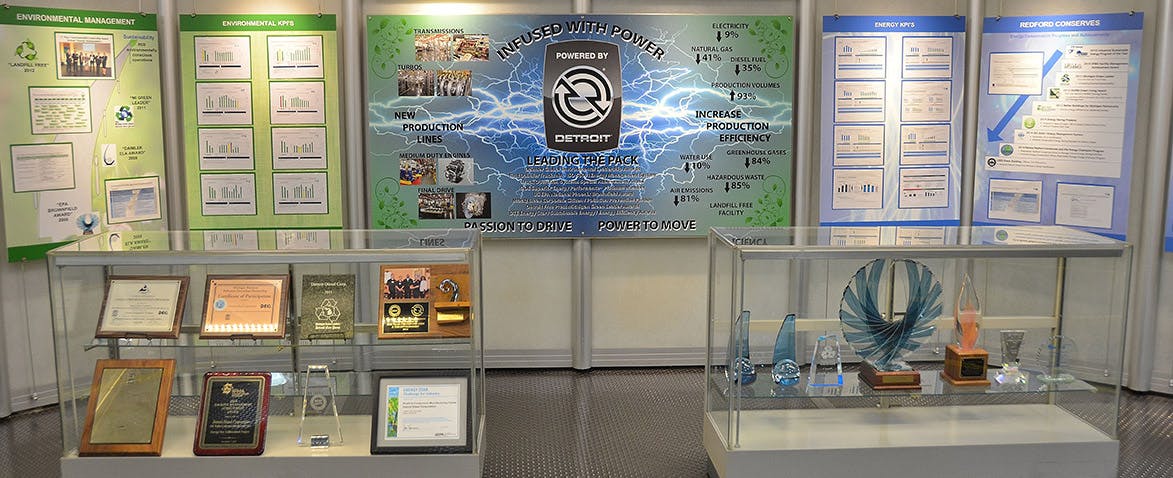

Within the past few years, the Environmental Protection Agency (EPA) has introduced strict emissions standards in order to reduce harmful pollutants from being released into the environment. Between 2002 and 2010, mandates have reduced allowable particulate matter and nitrogen oxides released into the atmosphere by over 90%. These regulations proved difficult to meet, but Detroit® engineers were successful by implementing Selective Catalytic Reduction (SCR) technology.
Detroit® engineers use our SCR emissions technology to reduce emissions and improve fuel economy. Our engines continue to provide the industry with clean, efficient and reliable technology and are certified to Greenhouse Gas 2017 (GHG17) regulations. These mandates and certifications are part of the EPA and the Department of Transportation’s Highway Traffic Safety Administration’s (NHTSA) first-ever program to reduce heavy and medium-duty truck Greenhouse Gas (GHG) emissions.
We are proud to be pacing the industry in technologies that not only reduce greenhouse emissions, but also improve fuel economy for our customers.
Our emissions system combines exhaust gas recirculation (EGR), selective catalytic reduction (SCR), diesel oxidation catalyst (DOC) and the diesel particulate filter (DPF) to efficiently meet the current emissions standards. SCR treats the exhaust gases downstream of the engine instead of requiring complex changes under the hood. It does this by injecting a small amount of diesel exhaust fluid (DEF) into the exhaust stream. DEF reacts with the NOx in the SCR catalyst to form nitrogen and water. Then, the nitrogen and water, safe elements in the air we breathe, are released into the environment.
SCR emissions technology helps engines perform at their peak. It requires less EGR, helping our engines run more efficiently. This allows them to perform at optimal combustion ranges to provide peak power and reduce heat rejection on many of the internal engine components. Another major contributing factor to this improvement is that the engine’s diesel particulate filter (DPF) have been updated to help extend its regeneration intervals. Ultimately, SCR leads to better durability, greater reliability, and lower lifecycle costs.
The innovative 1-Box™ Configuration, available only with Detroit® engines, combines the SCR catalyst, the diesel oxidation catalyst (DOC), diesel particulate filter (DPF) and diesel exhaust fluid (DEF) into one compact component. Combining all of these systems lowers engine back-pressure and reduces overall weight, yielding better fuel economy. The 1-Box comes standard on every truck, in combination with the engine of your choosing. The system's job is to reduce NOx and capture and burn off (regenerate) the particulate matter (soot) in the engine’s exhaust gas. It does this using a DOC and a DPF. By monitoring exhaust gas temperature and system back pressure, DDEC® control module determines the most efficient way required to ensure complete regeneration of the soot captured in the DPF.
Depending on engine duty or application, DDEC may notify the driver that stationary regeneration is necessary. Once the driver begins the stationary high-idle regeneration process, it typically takes up to 45 minutes to complete.
When required, DDEC gets help from two key upstream components that assist in a process called active regeneration. This process of active regeneration happens during the normal operation cycle of the vehicle.
Maintaining your Aftertreatment System is easy, because we designed it that way. The Diesel Particulate Filter (DPF) collects ash and will eventually need to be replaced, but the DDEC system will alert you when filter replacement is required. In addition to proper DPF maintenance, make sure the Detroit® recommended maintenance intervals are followed to ensure your Aftertreatment system is performing to its full potential. These include the following items, as well as any additional items mentioned in your Operator’s Manual.
• Oil Change
• Air Filter
• Fuel Quality
• Proper DEF and fluid levels. (Remember not to put DEF in the fuel tank or fuel in the DEF tank!)
Reference your Detroit® Engine Driver’s Card for more information on DEF indicator lamps and the parked regeneration procedure.
Note: Detroit® Reman DPF’s are currently not for sale or installation in California
If the DPF needs more extensive service, use the Detroit® Genuine Parts Replacement program. Your DPF will be replaced with our signature Detroit® Genuine Parts brand, while the old core is sent back to our factory for an extensive proprietary, environmentally friendly washing service.
Aftermarket cleaning methods, such as “bake & blow”, leave harmful ash residue in the filter. This will potentially lead to aftertreatment system damage, increased downtime, and additional maintenance costs. Only remanufactured Detroit® Genuine Parts DPF’s utilize a proprietary cleaning process proven to remove over 95% of the ash from your DPF. It’s the only DPF cleaning process you can trust.
Aftertreatment Systems need diesel fuel with sulfur content below 15ppm. Higher sulfur content may eventually cause damage to your Aftertreatment System by fouling or prematurely plugging the Diesel Particulate Filter. Using the correct fuel is essential to the proper function of your Aftertreatment System, while also helping lower emissions.
Learn more about DPF Cleaning
DEF is a simple, non-toxic, inexpensive pre-mixed fluid composed of two-thirds pure water and one-third automotive-grade urea. It’s used as a catalyst by SCR-equipped engines to reduce oxides of nitrogen (NOx) emissions. Tanks range in size from 6 to 23 gallons depending on the truck’s application, which means you, can go thousands of miles between fill-ups. DEF is sold at thousands of locations throughout North America. To find your nearest DEF location, visit DiscoverDEF.com.
discover defLearn more by visiting your nearest Freightliner or Western Start dealership.
Find the Nearest Dealer